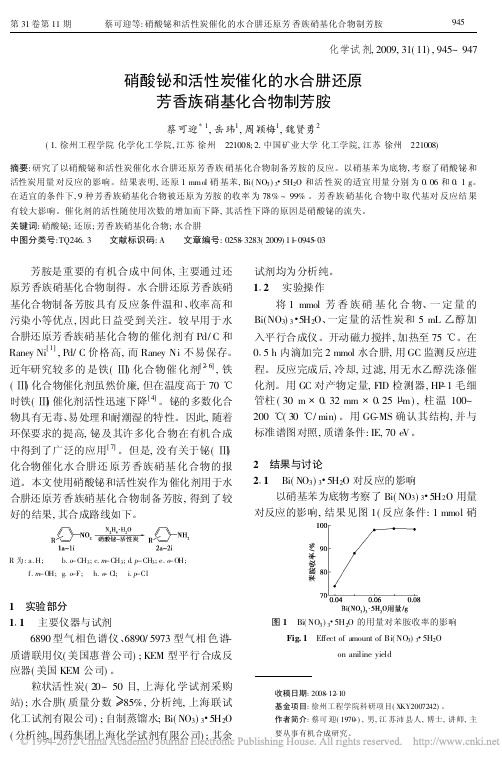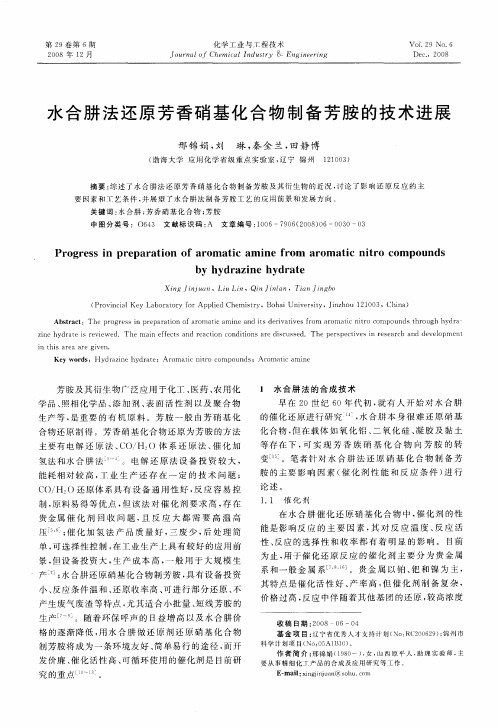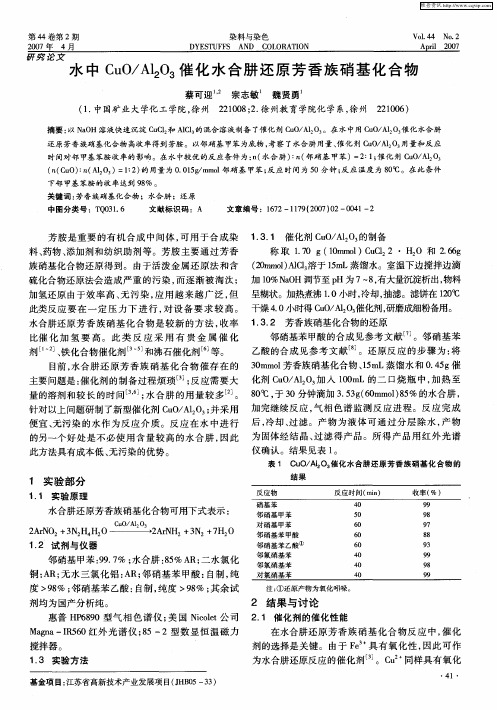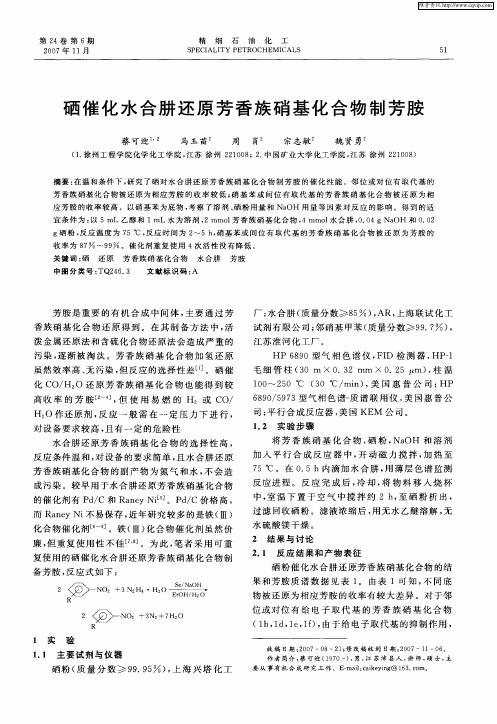芳香族硝基化合物的水合肼催化还原反应的研....
芳硝基物的水合肼催化还原研究进展

芳硝基物的水合肼催化还原研究进展芳胺是染料、医药、农药生产的重要中间体,通常由芳硝基物还原制得,如铁粉还原、硫化碱还原、催化加氢等。
其中铁粉还原法在还原硝基的同时使反应物分子中的氰基、偶氮基、多硝基还原,且还原得到的氨基物不能直接用于药物合成,同时还产生大量含有机物的铁泥。
硫化碱还原法虽能选择性地部分还原,但排放大量对生态不利的含硫废水。
目前大规模芳胺的生产都采用催化氢化法,采用的催化剂有Ni、Cu、Co、Pt、Pd以及金属氧化物等,催化氢化法为清洁工艺,不产生废弃物,但需在封闭的高压系统中反应,对安全防范要求较高,设备一次投资也高。
水合肼还原法则具有清洁、常压进行、后处理简单、转化率高等特点,其收率与催化氢化法相当,而且不还原硝基物分子中的氰基,水合肼不过量的情况下也不还原偶氮基;尤其适合多用途间歇式常压反应器内小批量精细化工产品的生产。
近年来,由于人们的生态和经济意识不断增强,水合肼催化硝基物还原成为研究热点,研究的重点主要集中在价廉、可循环使用的催化剂开发、硝基物分子结构对还原反应的影响等方面。
一、催化剂的影响水合肼还原研究初期采用的催化剂主要为贵金属(Pt、Pd、Ru、Ni等)。
研究发现Raney Ni的催化效果比Pd/C好;而Raney Ni中加入痕量Pt催化效果得到明显改善,大大缩短还原反应时间。
由于贵金属价格高,人们又将目光转向价廉的铁化合物等作为水合肼还原的催化剂。
宫田敏行等以对硝基甲苯(0.Olmol)为反应物,系统研究了氧化铁的不同形式对还原反应收率的影响,其结果表明,在六种铁氧化物中,β-氢氧化氧铁的催化效果最好,在催化剂用量为10g/mol硝基物的条件下,还原产率为93.2%;其次是针铁矿,产率为55.2%。
M.Benz等以X-射线衍射及穆斯鲍而(能)谱为手段,详细研究了氢氧化氧铁粒径以及不同形式氢氧化氧铁的表面积对还原反应速率常数的影响。
由图可清楚地看出,催化剂的表面积是其催化活性的重要影响因素,表面积越大,催化活性越高。
芳香硝基化合物的还原

芳香硝基化合物的还原芳香硝基化合物是一类化合物,其中的硝基基团(NO2)连接在苯环或其他芳香环上。
这些化合物具有特征性的香味,并广泛应用于医药、农业和化学工业。
然而,芳香硝基化合物也具有一定的毒性和危险性。
为了减少这些化合物的有害影响,研究人员已经开发了多种方法进行芳香硝基化合物的还原反应。
本文将详细介绍芳香硝基化合物的还原反应机理、反应条件以及应用领域。
芳香硝基化合物的还原反应主要涉及硝基基团的还原,将硝基基团还原为氨基或氢基。
这些反应通常可以分为化学还原和生物还原两种类型。
一、化学还原方法1. 金属还原剂一些金属还原剂,如亚铁盐(Fe(II))或铁粉,可以用于芳香硝基化合物的还原。
在这些反应中,金属还原剂与硝基基团发生电子转移反应,将硝基基团还原为氨基基团。
此外,金属还原剂还可以将硝基基团还原为氢基。
这些反应通常在碱性条件下进行。
2. 碱性溶液将芳香硝基化合物溶解在碱性溶液中,可以通过受控的亲电取代反应将硝基基团还原为氨基基团。
这种方法通常适用于硝基基团被其他基团所取代的化合物。
3. 亲核取代反应一些亲核试剂,如硫醇或亚磷酸酯,可以与芳香硝基化合物发生亲核取代反应,将硝基基团还原为氨基基团。
这些反应通常在碱性条件下进行。
4. 氢气还原氢气还原是一种常用的将硝基基团还原为氨基基团的方法。
在催化剂存在的条件下,芳香硝基化合物与氢气发生加成反应,生成相应的氨基化合物。
二、生物还原方法1. 微生物还原一些微生物,如革兰氏阳性菌和绿藻等,具有还原芳香硝基化合物的能力。
这些微生物通常在厌氧条件下生长,并通过酶系统将硝基基团还原为氨基或氢基。
2. 酶催化反应一些酶,如氧化还原酶和氮测定酶等,具有将硝基基团还原为氨基或氢基的能力。
这些酶通常在适宜的温度和pH条件下活性高效。
芳香硝基化合物的还原反应具有广泛的应用领域。
首先,还原反应可以用于合成具有生物活性的化合物。
许多药物和农药在合成过程中需要进行硝基还原反应。
硝基化合物还原方法研究报告

硝基化合物还原方法研究报告硝基化合物还原方法研究报告芳胺是重要的有机合成中间体和原料,用于合成农药、医药、橡胶助剂、染料和颜料、合成树脂、纺织助剂、表面活性剂、感光材料等多种精细化学品。
芳胺可由相应的芳香硝基化合物还原得到,工业中还原芳香硝基化合物的方法主要有金属(铁粉、锌粉等)还原法、催化加氢还原法和硫化碱还原法,而其他还原方法也多有研究。
最近,针对铁粉还原法制备芳胺的过程中,存在含盐废水的污染问题,还提出了许多绿色,环境友好的还原硝基物制相应芳胺的新方法。
1 金属还原法金属还原法,尤其铁粉还原法适用面广、操作简单、还原效率高、选择性好、产品质量好,尤其对品质有特殊要求的芳胺的制备,仍有优越性。
适宜于采用铁粉还原法生产的胺类有:①容易被水蒸气蒸出的芳胺;②易溶于水,并且可以通过蒸馏分离的芳胺;③能溶于热水的芳胺;④含磺酸基或羧酸基等水溶性基团的芳胺。
近年来,仍有许多关于各种活化铁还原芳香硝基化合物,以适合特殊芳胺制备方法的研究。
Hazlet、孙权一、LIU等分别制成了活化铁,还原各种芳香硝基化合物,相应芳胺的收率很高,对于那些易还原的基团不影响。
除了铁粉外,锌粉也用于还原芳香硝基化合物制芳胺,锡也是一种常用的还原剂。
另外,用镁粉,锰粉,铟、钐以及活性镍等作为还原剂,还原芳香硝基化合物也有研究。
这些金属还原芳香硝基化合物制备相应芳胺,均可获得较高收率的芳胺。
与铁粉相比,这些金属的价格较贵,有些还非常容易氧化。
而且多数反应还需要催化剂或其他条件辅助作用,反应后都会产生含盐的废弃物。
2 催化加氢还原法在催化加氢还原反应过程中,不产生有害副产物,废气、废液排放很少。
由于催化加氢还原硝基苯制苯胺的产量大,产品质量高,对解决环境污染问题有着显著的优越性,目前已经成为工业上生产苯胺的主要方法。
其缺点是对于苯环上有其他易还原取代基的芳香硝基化合物,其催化加氢过程中会发生大量副反应。
为了抑制这些副反应,一种方法是对催化剂进行改性,常用于催化加氢还原硝基物的催化剂有:铂基催化剂心、钯基催化剂、钌基催化剂、金基催化剂、骨架镍催化剂以及非晶态合金催化剂。
芳香族硝基化合物及偶氮化合物还原的简单方法

一、引言
芳香族硝基化合物和偶氮化合物是有机合成中常见的重要类别,它们在药物、农药、香料、染料等领域中都有广泛的应用。
然而,由于它们的稳定性和活性,它们的还原反应是一个挑战。
本文将介绍一种简单的方法来还原芳香族硝基化合物和偶氮化合物。
二、原理
芳香族硝基化合物和偶氮化合物的还原反应可以通过电子转移反应来实现。
在这种反应中,还原剂将电子转移到芳香族硝基化合物或偶氮化合物的核心上,从而使其变得更稳定。
三、实验步骤
1.准备实验材料:芳香族硝基化合物或偶氮化合物,还原剂(如铂催化剂),溶剂(如乙醇),反应容器,搅拌器,温度控制装置等。
2.将芳香族硝基化合物或偶氮化合物放入反应容器中,加入溶剂,搅拌均匀。
3.加入还原剂,搅拌均匀。
4.调节温度,控制在适当的温度(一般为室温),搅拌均匀。
5.继续搅拌,直到反应完成(一般需要几小时)。
6.过滤反应液,收集还原产物。
四、结论
本文介绍了一种简单的方法来还原芳香族硝基化合物和偶氮化合物,
即通过电子转移反应来实现。
实验步骤简单易行,反应条件宽松,可以在室温下完成,反应时间较短,可以有效地还原芳香族硝基化合物和偶氮化合物。
硝酸铋和活性炭催化的水合肼还原芳香族硝基化合物制芳胺

化学试剂,2009,31(11),945~947硝酸铋和活性炭催化的水合肼还原芳香族硝基化合物制芳胺蔡可迎*1,岳玮1,周颖梅1,魏贤勇2(1.徐州工程学院化学化工学院,江苏徐州 221008;2.中国矿业大学化工学院,江苏徐州 221008)摘要:研究了以硝酸铋和活性炭催化水合肼还原芳香族硝基化合物制备芳胺的反应。
以硝基苯为底物,考察了硝酸铋和活性炭用量对反应的影响。
结果表明,还原1mmol 硝基苯,Bi(NO 3)3 5H 2O 和活性炭的适宜用量分别为0 06和0 1g 。
在适宜的条件下,9种芳香族硝基化合物被还原为芳胺的收率为78%~99%。
芳香族硝基化合物中取代基对反应结果有较大影响。
催化剂的活性随使用次数的增加而下降,其活性下降的原因是硝酸铋的流失。
关键词:硝酸铋;还原;芳香族硝基化合物;水合肼中图分类号:TQ246.3 文献标识码:A 文章编号:0258-3283(2009)11-0945-03收稿日期:2008-12-10基金项目:徐州工程学院科研项目(X KY2007242)。
作者简介:蔡可迎(1970-),男,江苏沛县人,博士,讲师,主要从事有机合成研究。
芳胺是重要的有机合成中间体,主要通过还原芳香族硝基化合物制得。
水合肼还原芳香族硝基化合物制备芳胺具有反应条件温和、收率高和污染小等优点,因此日益受到关注。
较早用于水合肼还原芳香族硝基化合物的催化剂有Pd/C 和Raney Ni[1],Pd/C 价格高,而Raney Ni 不易保存。
近年研究较多的是铁( )化合物催化剂[2-6],铁( )化合物催化剂虽然价廉,但在温度高于70 时铁( )催化剂活性迅速下降[4]。
铋的多数化合物具有无毒、易处理和耐潮湿的特性。
因此,随着环保要求的提高,铋及其许多化合物在有机合成中得到了广泛的应用[7]。
但是,没有关于铋( )化合物催化水合肼还原芳香族硝基化合物的报道。
本文使用硝酸铋和活性炭作为催化剂用于水合肼还原芳香族硝基化合物制备芳胺,得到了较好的结果,其合成路线如下。
水合肼法还原芳香硝基化合物制备芳胺的技术进展

Pr g e s i r pa a i n o r m a i m i e f o o r s n p e r to f a o tc a n r m r m a i t o c m p u d ao tc nir o o n s b d a i e h dr t y hy r z n y a e
论述 。
1 1 催 化 剂 .
合 物还 原制得 。芳香 硝基 化合 物还原 为芳胺 的方 法
主要有 电解 还 原法 、 o H 0 体 系 还 原 法 、 化 加 c / 催 氢法 和水合 肼 法一 。电解 还 原 法 设 备 投 资 较 大 ,
能耗相 对较 高 , 业 生 产 还 存 在 一 定 的技 术 问 题 ; 丁 C ) H 0还 原体 系具有 设 备 通用 性 好 , (/ 反应 容 易 控 制 , 料易得 等优 点 , 该 法对 催 化 剂要 求 高 , 在 原 但 存 贵金属 催 化 剂 回 收 问 题 , 反 应 大 都 需 要 高 温 高 且 压 ; 化 加 氢 法 产 品质 量 好 , 废 少 , 处 理 简 催 三 后
1 水 合 肼 法 的 合 成 技 术
早在 2 0世 纪 6 O年代 初 , 有 人开 始 对水 合 肼 就 的催化 还原 进行研 究 , 水合 肼本 身 很难 还 原 硝基 化合 物 , 在载体 如 氧 化 铝 、 氧化 硅 、 胶 及 黏土 但 二 凝 等存 在 下 , 实 现 芳 香 族 硝 基 化 合 物 向芳 胺 的转 可 变 : 。笔者 针对 水 合 肼 法 还 原 硝 基化 合 物 制 备芳 胺 的主要 影 响 因素 ( 化 剂性 能 和 反 应 条件 ) 行 催 进
水中CuO/Al2O3催化水合肼还原芳香族硝基化合物

中图分类号 :T 0 16 Q 3.
文献标识码 :A
文章编号 :17 62—17 (0 7 0 0 4 2 19 20 )2— 0 1—
芳胺是重要 的有机合成 中间体 , 可用于合 成染 1 3 1 催化剂 C O A2 3 .. u / 1 的制备 O
料、 物 、 药 添加 剂和 纺 织助 剂等 。芳 胺 主要 通 过 芳 香
结 果
水合肼还原芳香族硝基化合物可用下式表示 :
C 0/ , u A1 O
2 NO2+3 H4 O ——— Ar N2 H2
Ar NH2+3 N2+7 O H2
1 2 试剂 与仪 器 .
邻硝基 甲苯 :97 水合肼 : %A ; 9. %; 8 5 R 二水氯化
铜 : R; 水 三 氯 化 铝 : R; 硝 基 苯 甲酸 : A 无 A 邻 自制 , 纯
蔡 可迎 宗 志敏 。 魏 贤 勇。
(. 1 中国矿业大学化工学院, 州 2 10 ;. 州教育学院化学 系, 徐 20 82 徐 徐州 2 10 ) 206
摘要 : N O 以 a H溶液快速 沉淀 C C2 A C3 u 1和 11的混合溶液制备 了催化剂 C O A2 3 u / 1 。在水 中用 C O A2 3 化水合肼 O u / 1O 催
(,C O) / A2 3 / u :, 1O )=12 的用量为 0 05 / m l 7 ( 7 ( :) . 1g m o 邻硝基 甲苯 ; 反应 时 间为 5 0分钟 ; 反应 温度 为 8  ̄ 。在此 条件 0( 2 下邻 甲基 苯胺 的收率达到 9 % 。 8
关 键 词 : 香 族 硝 基 化 合 物 ; 水合 肼 ;还 原 芳
维普资讯
硒催化水合肼还原芳香族硝基化合物制芳胺

芳 香 族 硝 基 化 合 物 被 还 原 为 相应 芳胺 的收 率 较 低 ; 基 苯 或 间 位 有 取 代 基 的 芳 香 族 硝 基 化 合 物 被 还 原 为 相 硝
应 芳 胺 的 收 率 较 高 。以 硝 基 苯 为底 物 , 察 了溶 剂 、 粉 用 量 和 Na 考 硒 OH 用 量 等 因 素 对 反 应 的影 响 。得 到 的 适 宜 条 件 为 : 5mL乙 醇 和 1mL水 为 溶 剂 , mo 芳 香族 硝基 化 合 物 , 以 2m l 4mmo 水 合 肼 , . 4gNa l 0 0 OH 和 0 0 .2 g硒 粉 , 应 温 度 为 7 反 5℃ , 应 时 间为 2 5 h 硝 基 苯 或 间 位 有 取 代 基 的 芳 香 族 硝 基 化 合 物 被 还 原 为 芳 胺 的 反 - ,
收 率 为 8 - 9 。催 化 剂 重 复 使用 4 活性 没 有 降低 。 7 9 次 关键词 : 硒 还原 芳 香 族 硝 基 化 合 物 水 合 肼
文献 标 识 码 : A
芳 胺
中图 分 类 号 : TQ2 6 3 4 .
芳胺 是重 要 的有 机 合 成 中 间体 , 主要 通 过芳 香 族硝基 化 合物 还 原 得 到 。在 其 制 备 方 法 中 , 活 泼 金属还原 法 和含硫 化合物 还原 法会 造成严 重 的 污染 , 逐渐 被 淘 汰 。芳 香 族 硝 基化 合 物 加 氢还 原 虽然效 率 高 、 污染 , 反应 的选择 性差 口 。硒 催 无 但 ] 化 C H 还原 芳 香 族 硝基 化 合 物 也 能得 到 较 O/ O 高收 率 的 芳 胺 ] 但 使 用 易 燃 的 H , 或 c / o H O作 还原剂 , 应 一 般 需 在 一 定 压 力 下 进 行 , 反 对设 备要求 较高 , 有 一定 的危险性 且 水 合肼 还原芳 香 族 硝 基 化合 物 的选 择性 高 , 反应条 件温 和 , 对设 备 的要求 简单 , 水 合肼还 原 且 芳 香族 硝基化 合 物 的 副产 物 为氮 气 和 水 , 会 造 不 成污染 。较早 用 于水合肼 还原 芳香族 硝基 化合 物
- 1、下载文档前请自行甄别文档内容的完整性,平台不提供额外的编辑、内容补充、找答案等附加服务。
- 2、"仅部分预览"的文档,不可在线预览部分如存在完整性等问题,可反馈申请退款(可完整预览的文档不适用该条件!)。
- 3、如文档侵犯您的权益,请联系客服反馈,我们会尽快为您处理(人工客服工作时间:9:00-18:30)。
件组合。
计算书可以直接提交设计部门进行工业设计。
4 结论作者对从C 4齐聚物分离2, 4, 4-三甲基戊烯的过程进行了精密分离研究, 应用Aspen Plus 流程模拟系统为工作平台建立了数学模型, 结合精确的定性和定量分析以及精馏热模试验, 实现了最终目的产品2, 4, 4-三甲基戊烯纯度95%、收率98%的分离结果, 超出预计指标。
由于采用了以数学模型为中心的研究思路, 热模试验主要以验证数学模型计算结果为目标, 目的性强, 研究周期缩短。
参考文献[1] Aspen T ech , Aspen Plus Release 9. 1User . s Guide, Vol. l&Vol.2, 1994[2] 鲍杰等, 齐鲁石油化工, (4 , 221(1994[3] 汪文虎等, 烃类物理化学数据手册, 烃加工出版社, 1990 (1997-07-05收稿=作者简介>鲍杰, 1984年毕业于华东工程学院化学工程专业, 1984年在中石化齐鲁石化公司研究院工作至今。
先后从事化工过程开发、流程模拟和精细化工等领域的研究工作。
发表论文多篇。
Study on the Precision Separation of 2, 4, 4-Trimethylpentenefrom C 4OligomersBao Jie, An Yam ing, Ding Wenguang(Qilu Petr ochemical Research I nstitute, Zibo , Shandong Pr ovince, Pos tcode 255400Abstract:The precision separation of 2, 4, 4-trimethy lpentene from C 4oligomers w as studied. The flowsheet simulation model of the process in Aspen Plus platform w as built up and the accurate analysis and a few bench -tests w ere accomplished. The results show ed that the purity of 2, 4, 4-tirmethy lpentene w as over 95%and the recovery yield reached 98%.Keywords:oligomers, 2, 4, 4-trimethylpentene, precision separation, Aspen Plus芳香族硝基化合物的水合肼催化还原反应的研究唐洪张蕾徐寿颐(清华大学化学系, 北京, 邮编100084摘要研究了以80%水合肼为还原剂, 在FeCl 3#6H 2O/C 存在下, 回流3~8h, 将芳香族硝基化合物转变成芳香族氨基化合物的还原反应。
相应的氨基化合物的产率达到85%~98%。
关键词催化还原反应, 水合肼, 芳香族氨基化合物芳香族硝基化合物转变成相应的氨基化合物是精细化工生产中常用的反应之一。
实现这一过程的方法很多, 如:(1 硫化物还原法; (2 金属在酸性、中性和碱性体系的还原法; (3 催化氢化法, 但这些方法各有缺点。
方法1和2后处理困难, 产品颜色深; 方法3催化剂制备困难, 且价格高。
而水合肼还原法以其方便、高产率得到了广泛的应用, 据文献报道, 水合肼还原法使用的催化剂主要有两类[1~3]:(1 Pd/C 、Pt/C 和Raney Ni, 此法尽管能顺利地还原芳香族硝基化合物, 且产率较高, 但它#43#第2期唐洪等:芳香族硝基化合物的水合肼催化还原反应的研究常常伴随着其它侧链的还原(CN 、COOR 等、需要较高浓度的水合肼(95%~100% 和水合肼必须大大过量以及催化剂价值较高、制备较复杂等缺点。
(2 FeCl 3#6H 2O/C, 此法克服了上述方法1的缺点, 它的还原效率非常高, 产率一般在85%~98%之间, 苯环侧链上有CN 、COOR 等基团时不受影响, 水合肼不必大大过量。
但仍然需要高浓度的水合肼。
作者以低浓度水合肼(80%~85% 为还原剂, 在FeCl 3#6H 2O/C 的催化作用下, 对芳香族硝基化合物的还原反应进行了详细的研究。
1 实验所用药品为CP 或AR 级试剂。
所用仪器为PE -2400型元素分析仪; SP -8800型液相色谱仪; Du Pont -900型DSC 仪。
111 原理水合肼还原芳香族硝基化合物的反应可用下式表示:ArNO 2+32N 2H 4FeCl #6H 2O C2+2H 2O+32N 2{112 实验操作11211 间氟苯胺的合成将1410g (0. 1mol 间硝基氟苯, 2g 活性炭, 20mg 六水三氯化铁和50ml 甲醇混合于250m l 三口瓶中, 加热回流片刻, 在1h 内慢慢滴加1515g (0125mol 80%的水合肼, 加完后回流反应混合物2h 。
冷却, 过滤除去反应混合物中的活性炭, 滤液在旋转蒸发器上除去甲醇, 用3@100ml 乙醚提取三次, 用硫酸钠干燥, 蒸除乙醚, 常压蒸馏, 收集188~190e 馏分(文献值190e , 得间氟苯胺的无色透明液体, 产率93%。
元素分析(C 6H 6FN :计算值(% :C, 64185; H, 5144; N, 12161。
实测值(% :C, 64176; H , 5136; N, 12165。
11212 其他芳香族硝基化合物的还原采用/112110合成方法还原了其它的芳香族硝基化合物。
表1列出了以80%水合肼为还原剂的还原条件芳香族氨基化合物的产率。
其熔点或沸点和元素分析数据如下::分析:计算值(% :C, 68127; H , 7137; N, 11137。
实测值(% :C, 68189; H , 7148; N, 11129。
邻氨基苯甲醚熔点:415e (文献值5e 。
元素分析:计算值(% :C, 68127; H , 7137; N,11137。
实测值(% :C, 68130; H, 7147; N, 11131。
对氨基苯甲醚熔点:57e (文献值57e 。
元素分析:计算值(% :C, 68127; H , 7137; N, 11137。
实测值(% :C, 68114; H, 7141; N, 11147。
苯胺沸点:105~108e /1333Pa 。
元素分析:计算值(% :C, 77138; H, 7158; N, 15104。
实测值(% :C, 77149; H, 7163; N, 15101。
邻氨基甲苯沸点:110~113e /1333Pa 。
元素分析:计算值(% :C, 78146; H , 8147; N, 13107。
实测值(% :C, 78129; H , 8135; N, 13118。
间氨基甲苯沸点:125~128e /1600Pa 。
元素分析:计算值(% :C, 78146; H , 8147; N, 13107。
实测值(% :C, 78152; H , 8160; N, 12198。
对氨基甲苯熔点:45e (文献值44~45e 。
元素分析:计算值(% :C, 78146; H , 8147; N, 13107。
实测值(% :C, 78160; H, 8152; N, 13101。
间氨基苯腈熔点:53e (文献值5215~53e 。
元素分析:计算值(% :C, 71116; H, 5112; N, 23172。
实测值(% :C, 71128; H, 5120; N, 23165。
间氨基苯酚熔点:122e (文献值122~123e 。
元素分析:计算值(% :C, 66103; H, 6147; N, 12184。
实测值(% :C, 66120; H , 6156; N, 12170。
表1 以80%水合肼为还原剂的还原条件与结果Ar -NO 2(0. 1mol还原条件FeCl 3#6H 2O/mg/g回流时间/hAr -NH 2产率/%间硝基苯甲醚50/2593邻硝基苯甲醚50/2592对硝基苯甲醚50/2592硝基苯20/1398邻硝基甲苯20/1397间硝基甲苯20/1397对硝基甲苯20/1398间氟硝基苯50/2593间硝基苯腈100/2890#44#精细化工 FI NE CHEM ICA LS 1998年总第15卷2 结果与讨论表2列出了011mol 对硝基甲苯在不同还原条件下的还原结果。
表2 011mol 对硝基甲苯在不同还原条件下的结果水合肼浓度/%用量/mol 催化剂名称用量Ar -NH 2产率/%参考文献96158080011501150125FeCl 3/C FeCl 3/C FeCl 3/C 20mg/2g 20mg/2g 20mg/2g 98. 97592[1]--8080016016Raney Ni Pd/C0. 5g 0. 5g80~9089. 2[2][3]由表1和表2的结果可见:(1 以80%水合肼为还原剂, 在FeCl 3#6H 2O/C 的催化作用下, 还原芳香族硝基化合物的产率一般均大于85%。
产品颜色为浅黄色或无色。
在实验过程中, 水合肼必须慢慢滴加, 否则产率降低。
(2 水合肼浓度为80%和9615%时, 还原反应的产率相近, 但水合肼的用量有较大的差别。
不同浓度的水合肼与硝基化合物按反应方程式的摩尔比115B 1投料时, 显然高浓度的水合肼有更高的还原产率。
为了达到同样的还原结果, 必须加大80%水合肼的用量, 水合肼与硝基化合物的摩尔比至少要达到215B 1。
尽管如此, 由于80%水合肼比高浓度水合肼价格低得多, 制备的成本仍然较低。
(3当水合肼的浓度为80%、使用不同催化剂、且水合肼用量一定时, 用FeCl 3#6H 2O/C 作催化剂有更高的还原产率。
而使用Raney Ni 和Pd/C 作催化剂时, 必须加入大大过量的水合肼才能将硝基化合物完全还原。
(4 当芳香族硝基化合物中含有CN 、OH 等基团时, 必须加大催化剂FeCl 3#6H 2O/C 的用量, 这可能是因为CN 、OH 等基团易于与FeCl 3络合的缘故。
(5 若以对氟硝基苯、邻氟硝基苯等硝基的邻对位有卤素原子的芳香族硝基化合物为反应物, 采用本文的方法还原时, 未得到预期的芳香族氨基化合物, 这可能是因为卤素原子在硝基的邻、对位时相当活泼, 易发生取代、脱卤等反应, 所以产物相当复杂, 此反应的机理有待于进一步研究。
参考文献[1] Tsuneaki H, et al , Chem L ett , 259(1975 [2] Fletcher T L, et al, J Org Chem , 23, 680(1958 [3] Furst A, Chem Rev , 65, 51(1965 (1997-05-19收稿=作者简介>唐洪, 1964年生, 1993年获清华大学有机化学专业理学硕士学位。
